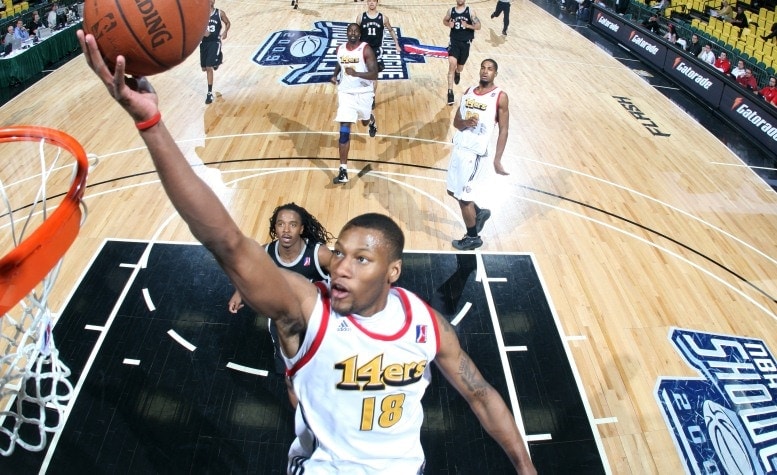When Sonny Weems walked into US Airways Center for the first time last week, he took a few extra minutes soak in his NBA home.
A security guard saw the 6-6 guard and assumed the worst.
“You lost?” he asked.
“Nah, man,” Weems replied. “I’m just enjoying this.”
You’ll forgive Weems for doing so. The road back to professional state-side basketball has been a long one. Make no mistake, he’d travel it again if he could, and not just to reach his destination.
“I just took a different route,” Weems said. “I have no regrets about it. It improved me on and off the court.”

That route twisted as soon as it started on draft day, 2008. His athleticism and shooting in two years at Arkansas had placed him firmly in the second-round radar. The second round of the draft, however, is anything but firm.
“My agent actually called me before I got picked and said, ‘Denver’s going to trade up to get you,’” Weems recalled. “‘Chicago’s going to pick you, but you’re actually going to go to Denver.’”
He didn’t care who owned his draft rights. Weems had grown up in West Memphis, Arkansas, a town home to less than 30,000 people. As long as his jersey sported an NBA logo, he didn’t care which city it represented.
By the time he saw his first action on the court, however, his jersey said “D-League.” Denver, already carrying Carmelo Anthony, Chauncey Billups, J.R. Smith and Linas Kleiza on the perimeter, assigned Weems to the Colorado 14ers for the majority of his rookie season. He wound up laying just 12 games for the Nuggets, mostly in garbage-time settings that negated the whatever he tried to prove.
After the Nuggets advanced to the 2009 Western Conference Finals, they mortgaged Weems’ future for the present benefit of a veteran big man, dealing him to Milwaukee. Less than three weeks later, the Bucks flipped Weems to Toronto in another trade.
The younger Raptors, still struggling to establish an identity at the time, gave Weems his first taste of meaningful NBA basketball. He played in 69 games that season, averaging just under 20 minutes per game. In his first start, he scored 21 points.
Toronto missed the playoffs by one game, but Weems, it seemed, had made it in the league.

The 2010-11 season provided further room for him to grow. Chris Bosh’s departure to Miami buried Toronto in full rebuild mode. Weems was one of the bright spots, ranking second on the team in scoring through the first month of the season. He finished with career-highs in points, assists, free throw and three-point shooting percentages.
Despite Weems’ progress, Toronto declined to pick up his 2011-12 contract option. Then the lockout happened. With his NBA status tenuous and the start of the season uncertain, Weems kept his basketball career alive by putting his NBA dream on hold. Of all the NBA players who signed contracts in leagues overseas, he was the only one to do so without an “out” clause in his contract. In Europe, he decided, he’d hone his skills until he was sure of his stateside value.
“I was young, so I wanted to continue to play basketball,” Weems said. “I couldn’t get better if I was just working out every day.”

Weems did get better, first in Lithuania, then in Moscow. In the latter city, he played for powerhouse CSKA. Experienced coaches and veterans helped him harness the other-worldly athleticism that won him high school championships in the long jump and high jump as well as the Lithuanian league’s slam dunk contest. He also worked on his previously flawed three-point shooting.
The results were immediate. By 2014-15, Weems was shooting better than 40 percent from three-point range while leading all Euroleague non-guards in assists. His success mirrored that of his team; CSKA qualified for the Euroleague Final Four in each of his three seasons with the team.
Before his final season in Moscow, Weems had signed a new, two-year contract with CSKA. This time, it had an out clause. After his 2014-15 campaign, he knew he’d generated enough interest to use it.
Weems was vacationing in Mexico when a friend woke him up.
“Man, you’re going to Phoenix!” he exclaimed.
Still groggy with sleep, Weems struggled to process what he’d just been told. Phoenix? He had no clue they’d been interested. He knew FC Barcelona, one of the best non-NBA professional teams in the world, had him on their radar. Several NBA teams inquired into his availability as well.
“Every basketball player growing up, their dream is to play in the NBA. Now I’m back.”
— Sonny Weems
Phoenix was new, though. More importantly, it was done. He was a Sun. Once he digested this fact, he started to smile.
Phoenix. They liked to run. They’d done so since the Steve Nash and Amar’e Stoudemire days he’d watched unfold in high-flying fashion as a high-school kid. More recently, he’d seen enough to know Head Coach Jeff Hornacek had reinstated the Suns’ up-tempo identity.
A few weeks later, he arrived at his NBA home, a place he’d left nearly half a decade ago with zero assurances he’d ever return. He still keeps a jersey from every team he’s worn along the way: high school, junior college, Arkansas, D-League, Denver, Toronto, Lithuania, Moscow.
Weems has been a lot of places. But no, he was never lost, not even if he looked the part in his first day back in the big leagues.
“Every basketball player growing up, their dream is to play in the NBA,” Weems said. “Now I’m back.”
